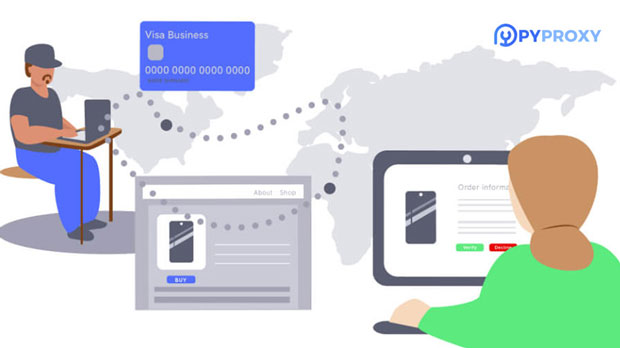When discussing proxy protocols, SOCKS5 stands out for its versatility and security, especially when used in HTTP mode. A socks5 proxy provides a higher level of anonymity and security by masking the user's IP address and allowing secure, unrestricted access to the internet. It works with all types of traffic, whether it’s browsing, torrents, or any other data transfer. By using SOCKS5 in HTTP mode, users can ensure secure, private, and fast connections without limitations, making it a preferred choice for users who prioritize security and anonymity. This article will dive deeper into how this proxy works, its advantages, and why it's particularly effective for HTTP traffic. Understanding SOCKS5 Proxy in HTTP ModeBefore diving into the advantages, it is crucial to understand what SOCKS5 is and how it operates in HTTP mode. SOCKS5 is a proxy protocol designed to route internet traffic through a middle server, making the connection more secure and anonymous. Unlike traditional HTTP proxies, SOCKS5 does not rewrite or alter traffic; it simply routes it through the server. This results in enhanced security and privacy because it does not rely on the application layer, making it less susceptible to potential data leaks or security threats.When used in HTTP mode, SOCKS5 allows HTTP-based web traffic to pass through the proxy server, thereby masking the user's IP address from the websites they visit. The HTTP mode specifically handles web browsing requests, allowing for more efficient and secure browsing compared to standard proxies. It is compatible with all browsers and applications that use HTTP, making it extremely versatile.Key Benefits of Using SOCKS5 Proxy in HTTP Mode1. Enhanced Anonymity and PrivacyOne of the most significant benefits of using SOCKS5 in HTTP mode is the increased anonymity it offers. The proxy server hides the user’s real IP address and replaces it with one from the proxy server. This ensures that any website the user visits only sees the proxy’s IP address and not the actual user’s address, effectively masking their online presence. This level of privacy is particularly beneficial for individuals who want to safeguard their identity, bypass geographic restrictions, or prevent websites from tracking their browsing behavior.Furthermore, since SOCKS5 doesn’t modify the traffic, it offers a more secure and less detectable browsing experience compared to other types of proxies. Many websites today are designed to detect and block proxies, but SOCKS5 remains one of the most difficult protocols for detection, especially in HTTP mode.2. Bypass Geo-Restrictions and CensorshipUsing a SOCKS5 proxy in HTTP mode allows users to bypass geo-restrictions and censorship imposed by governments or service providers. Many websites restrict access based on geographic locations, meaning that some content is only available to users in certain countries. By using SOCKS5, users can route their internet traffic through a server located in a different country, thereby accessing content that would otherwise be unavailable in their region.This capability is also valuable for individuals living in countries with internet censorship, where access to certain websites or services may be restricted. SOCKS5 can help these users regain access to blocked content by bypassing government-imposed filters and firewalls.3. Improved Security and EncryptionWhile SOCKS5 itself doesn’t encrypt traffic (unlike other proxies such as HTTPS), it does provide a secure way to route traffic through a middle server. This can prevent man-in-the-middle attacks and protect against hackers trying to intercept communication between the client and the server. The security features offered by SOCKS5 make it more secure compared to other proxy types, such as HTTP proxies.When used in HTTP mode, SOCKS5 can ensure that your connection is secure, as it doesn’t expose your real IP address or transmit sensitive data in an unprotected format. This is especially crucial when accessing untrusted websites or using public networks, where the risk of cyber threats is higher.4. Faster Speeds and Improved PerformanceIn comparison to traditional proxies, SOCKS5 is known for providing faster speeds. The reason lies in how SOCKS5 handles traffic. It does not interfere with the data, meaning there is less processing time needed for routing traffic, resulting in faster speeds. Additionally, since SOCKS5 can handle any type of internet traffic, users are not limited to only browsing or specific applications. This flexibility means that SOCKS5 is particularly useful for users engaging in data-intensive activities such as streaming or torrenting, as it allows them to enjoy smoother and faster connections without throttling.When using SOCKS5 in HTTP mode, users also benefit from faster page load times and reduced latency. This is because the proxy server is designed to be efficient in handling web traffic, ensuring that browsing experiences are smooth and uninterrupted.5. Compatibility with Multiple ApplicationsAnother notable advantage of using SOCKS5 in HTTP mode is its compatibility with a wide range of applications. Whether you’re using web browsers, torrent clients, or other types of software that rely on internet connections, SOCKS5 can support them all. Unlike HTTP proxies, which are generally only suited for web browsers, SOCKS5 can handle all types of internet traffic, making it highly versatile.For businesses and individuals who need to secure multiple types of internet traffic, SOCKS5 provides an all-in-one solution. Whether you're browsing the web, using a P2P file-sharing platform, or engaging in other internet-based activities, SOCKS5 ensures that all traffic is routed securely through the proxy server.6. No Need for Authentication or Special Configuration sock s5 proxies are relatively simple to set up and use. In many cases, they do not require complex authentication methods or specialized configuration. Users can quickly set up SOCKS5 proxies in their preferred browsers or applications with minimal hassle, making it ideal for both beginners and experienced users alike.Additionally, because SOCKS5 does not require special handling of the traffic itself, users do not need to worry about manually configuring each application. This makes the process of maintaining a secure, anonymous connection simpler than with other types of proxies, which often require extra setup steps.In conclusion, using SOCKS5 proxy in HTTP mode provides several significant advantages, including enhanced privacy, better security, bypassing geo-restrictions, and improved browsing speeds. Its ability to support a wide range of internet traffic, from browsing to file sharing, makes it an ideal choice for anyone looking to maintain a secure and efficient online presence. Whether you're concerned about security, seeking better performance, or looking to access restricted content, SOCKS5 in HTTP mode is a versatile and reliable solution for users across different platforms and use cases.
Jun 18, 2025



































































